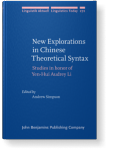Jo-wang Lin
List of John Benjamins publications for which Jo-wang Lin plays a role.
Journal
Articles
2024 名物化與「的」字結構 [Nominalization and de-constructions]: 談轉指與自指 [On shift and self designation structures] Language and Linguistics 25:3, pp. 453–495 | Article
本文討論朱德熙先生的名詞性標記「的3」,並對他提出的轉指和自指概念作更為深入的形式語意分析。文章首先釐清結構轉指與語境刪略分屬兩類不同語法現象。前者是在「X的」結構裡,對X裡的缺位成分抽象化為個體特徵後,再以iota算子把個體特徵轉化成為個體的語法過程,轉指過程不涉任何中心語名詞或空號代詞,是「X的」結構本身把陳述轉為稱代的語法操作。語境刪略則是「X的N」結構中,中心語名詞N因為語境可復原而將N刪略的現象,此時X可能有缺位成分或是沒有缺位成分。無缺位成分的是自指結構的「X的」,其偽轉指現象牽涉的是中心語名詞的語境刪略。此外,本文提出自指的「X的」與事件屬性名詞N組合時, read more
2022 Chinese comparatives: Commentary on clausal vs. phrasal analyses New Explorations in Chinese Theoretical Syntax: Studies in honor of Yen-Hui Audrey Li, Simpson, Andrew (ed.), pp. 249–292 | Chapter
This article aims to make a contribution to the recent debate between the phrasal and clausal analyses of Chinese comparatives, focusing on Lin (2009) for the phrasal approach and Liu (2011, 2014), Hsieh (2017) and Erlewine (2018) for the clausal approach. I show that problems such as lack of… read more
2021 Chapter 9. Quantifictional binding without surface c-command in Mandarin Chinese Current Issues in Syntactic Cartography: A crosslinguistic perspective, Si, Fuzhen and Luigi Rizzi (eds.), pp. 183–216 | Chapter
This article discusses quantificational binding without surface c-command in Mandarin Chinese. Jin (1998) pointed out that Chinese quantificational NPs (Q-NPs) headed by mei ‘every’ are capable of binding out of containers such as sentential subjects, relative clauses or adverbial clauses and… read more
2014 The adjective of quantity duo ‘many/much’ and differential comparatives in Mandarin Chinese International Journal of Chinese Linguistics 1:2, pp. 163–191 | Article
This article discusses differential comparatives involving the adjective of quantity duo ‘many/much’ in Mandarin Chinese. We show that the obligatory construal of a post-adjectival duo-phrase as a differential phrase rather than a degree modifier is due to the interaction of four factors: (i)… read more




